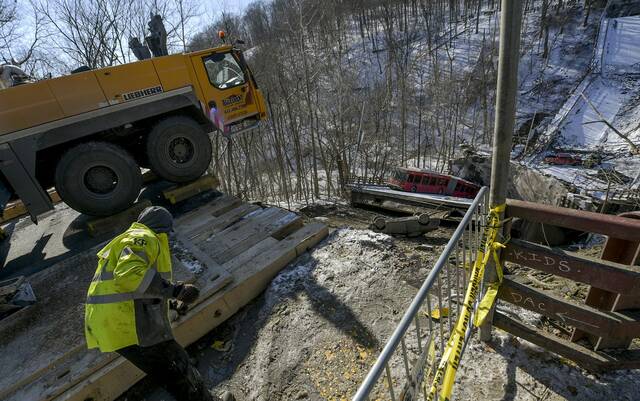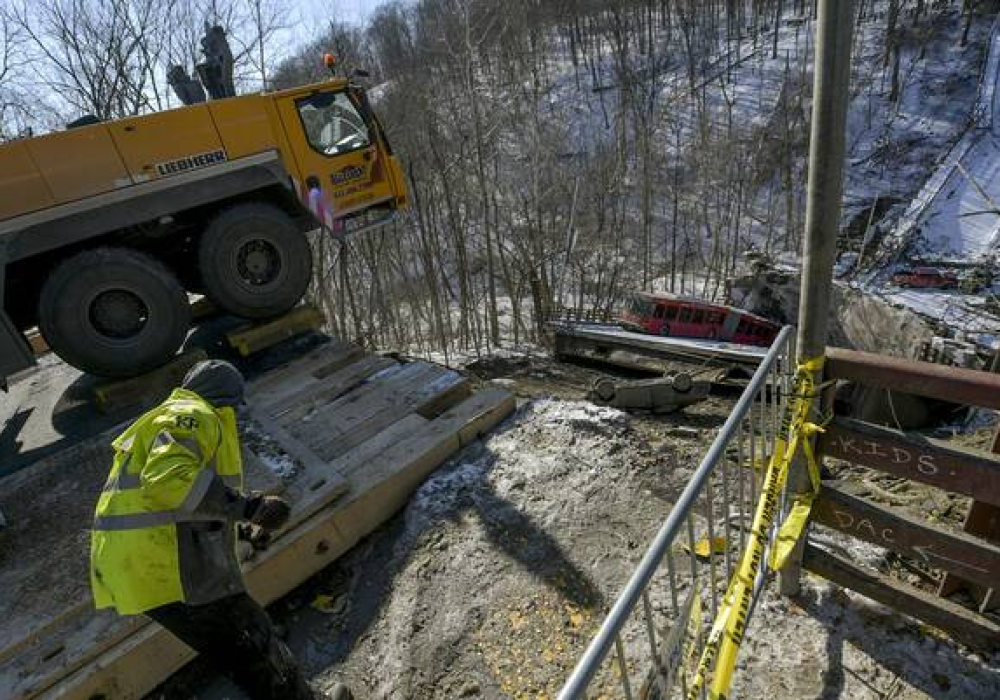The clean-up and investigation into the collapse of the Forbes Avenue bridge over Fern Hollow in Frick Park began in earnest Saturday, the first steps of what will likely be a long and arduous process, federal officials said.
“Over the coming weeks we are going to put this bridge under a microscope,” said Jennifer Homendy, chair of the National Transportation Safety Board. “We’re going to look at the entire history of this bridge, from the design, construction, maintenance, repairs — all the work up until the day of the collapse.”
Crews got their first real look at the bridge and debris Saturday, first from some hundreds of feet in the air via drone and later up close as they completed an initial inspection of the structure and supports under the bridge deck.
Homendy said extent of the destruction, when you see it up close, “takes your breath away.”
“We are really fortunate that no one died,” she said. “Injuries are very serious, but when I look at the bus and the position of the bus and the position of the vehicles, I’m really thankful that no one lost their life.
“The damage is massive.”
At least 10 people were injured in the collapse, officials said, but none of those injuries were believed to be life-threatening. Three people were taken to UPMC Presbyterian hospital for treatment, and one person was treated and released at UPMC Shadyside. All were adults and in fair condition Friday.
Related:
• It’s a resource problem’: 1 in 8 bridges in Pa. rated in ‘poor’ condition, records show
• Pittsburgh’s East Enders come to terms with the ‘unbelievable’ collapse of Frick Park bridge
The Port Authority bus that was on the bridge when it collapsed was equipped with nine cameras, including some pointing outward in all directions. Homendy said the quality of the video remains to be seen.
The coming days will see NTSB crews continue to examine each piece of the collapsed bridge, working to see how the structure came to rest and looking for signs of corrosion and fatigue cracking.
Some pieces could go back to the lab with investigators, Homendy said, and as debris is moved and lifted, new areas of interest could be discovered.
Chief among the debris will be the 60-footlong articulated bus. A 2019 Port Authority report said articulated buses have a curb weight of roughly 40,000 pounds, which includes the vehicle and a full tank of gas.
Homendy said the bus must be emptied of fuel before it can be removed.
A massive crane from Allegheny Crane Rental moved into position at the very edge of the remaining roadway on the Regent Square side of Forbes around noon.
NTSB releases b-roll video from Pittsburgh bridge collapse investigation: https://t.co/0JY5uFCMZd
— NTSB_Newsroom (@NTSB_Newsroom) January 29, 2022
The 447-foot span, which is a major artery between Oakland and Regent Square, was built in 1970, according to PennDOT records.
It is rated in poor condition and restricted to vehicles no more than 26 tons.
Homendy said investigators will look at the history of the bridge, including inspection frequency, inspection quality, federal and state inspection procedures.
They’ll look at the types of loads that move across the bridge, how those loads have changed, and how the types of vehicles using the bridge have changed over time.
Thelll also dig into traffic counts, the impact of weather on the span and the effects of road treatments.
The entire NTSB investigation and report will take anywhere from 12 to 18 months. A preliminary report containing only factual information will be released in about 10 days.
“Although we can’t determine the cause of the collapse while we’re on scene, this should serve as a call to action,” Homendy said.
Of 22,965 bridges in the state, nearly 53% are rated in fair condition and just over 14.5% are considered in poor condition, she said. Across the country, nearly 48% of 618,456 bridges are rated in fair condition and 7.3% are rated poor.
“This is a call to action because we have aging transportation infrastructure — bridges, tunnels,” Homendy said, “ and that is something that can begin to be address immediately.”
Megan Guza is a Tribune-Review staff writer. You can contact Megan at 412-380-8519, mguza@triblive.com or via Twitter .










